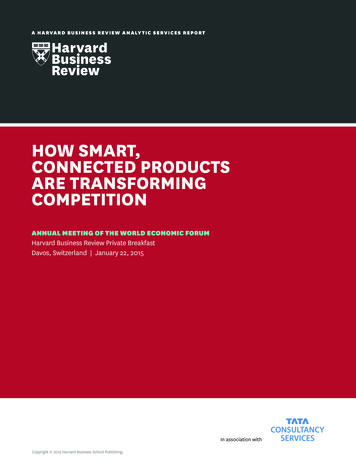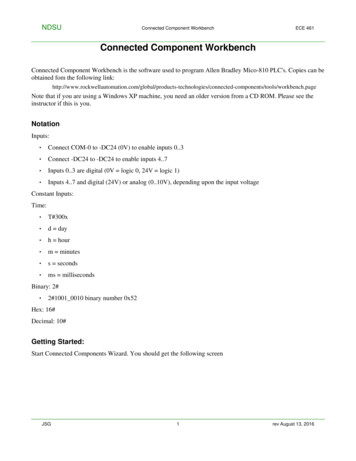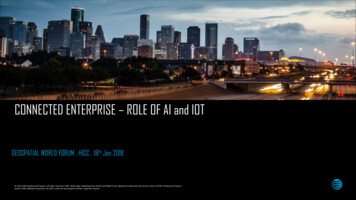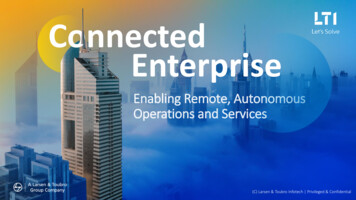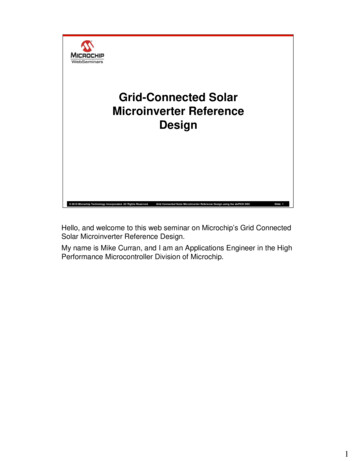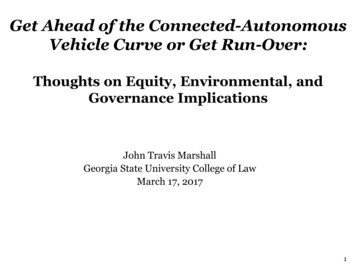
Transcription
Get Ahead of the Connected-AutonomousVehicle Curve or Get Run-Over:Thoughts on Equity, Environmental, andGovernance ImplicationsJohn Travis MarshallGeorgia State University College of LawMarch 17, 20171
2
Most common job by statein 2014Source: NPR
Equity Implications – TheGood Fully autonomous vehicles hold long-term promise forshared-use or “pooled” transport. But it will take time for these potential benefits to accrue4
Equity Implications –Adversity Near & mid-term price of autonomous vehicles isprojected to be prohibitive. Low- and moderate-income families lack access totechnology essential for ride sharing services. Potential automaker foot-dragging on development ofFully Autonomous Vehicles? Fundamental disruption to transportation sector. Fundamental disruption to rural communities.5
Implications for Governance –The PositiveSuburban renaissance Commutes without the daily traffic headaches.Potential to Reimagine or Redesign Public Infrastructure Rebalance the use of the right-of-way.Local Regulatory Reset The demise of the parking ratio?Diminished government outlays Seven percent of vehicle crash costs are paid for bypublic revenues (Desouza 2015)6
Implications for Governance-- The TroublingDiminished State & Local Revenues Policies at the federal and state levels for infrastructure funding mustbe revised to reflect the restructuring of the transportation systemunder automation. More efficient, computer-controlled, cars will mean lower gas taxrevenues Increasing popularity of vehicle sharing services will depress new andused car sales (Brasuell 2016) Progressively declining state revenues from yearly vehicle registrationfees (Desouza 2015) Steadily declining local revenues from speeding tickets, DUI fines, andtowing feesSuburban sprawl Advent of regular super-commutes – 75 miles, one way – in your ownpersonal ‘quiet car.’7
Environmental Implications -The PositiveDecreased Highway & City Road Congestion Even with potential increase in vehicle miles traveled . . . sharedvehicle services will allow highly efficient vehicle travel. “Platooning” of not only cars, but trucks, will ease traffic congestion,save fuel and improve air quality (West 2016) “Traffic jams” associated with red lights will diminish and ultimatelygo away thanks to Vehicle-to-Vehicle and Vehicle-to-Signalcommunication (West 2016)Redevelopment Opportunities for More Sustainable Cities: potential forincreases in green spaces and affordable housing in urban city centers Potential to transform urban parking lots to green space, affordablehousing, or in-town office & commercial (Geeting 2014; Economist2015) Note that parking sufficiency has been used to oppose urbanmulti-family affordable housing development.8
Environmental Implications –The ChallengesPotential Urban Grid Congestion “Congestion’s not going away,” some experts caution. “True, Google cars can get five times more cars throughintersections” than currently possible, “since they’ll drivecloser together.” “How’s that going to feel for pedestrians andcyclists?” (Geeting 2014)Proliferation of “Super Commuters” Potential push to adjust greenbelts and urban growthcontrols in light of long haul commuting. (Riggs et al. 2016)9
Some Historical Perspective onTransportation InnovationAn early 20th centuryrevolution . . . . . that helped solve an urbanhealth and environmental crisis.10
References Jonathan Geeting, It’s an Automatic: The Road to a Future of Driverless Cars, Dense Streets and Supreme Mobility, NEXTCITY, (February 10, s-cars-city-design-mobility-urban-planning Darrell West, Moving forward: Self-driving vehicles in China, Europe, Japan, Korea, and the United States, CENTER FOR TECHNOLOGYINNOVATION AT BROOKINGS, (September 2016), 09/driverless-cars-2.pdf Monica Anderson and Andrew Perrin, 13% of Americans don’t use the internet. Who are they?, PEW RESEARCH CENTER, (September 7, hey/ Preparing for Automated Vehicles: Recommendations from The National Association of City Transportation (NATCO), NATCO POLICY STATEMENTON AUTOMATED VEHICLES (June 25, 2016), Policy-Automated-Vehicles-201606.pdf William Riggs and Michael Boswell, Why Autonomous Vehicles probably won’t induce sprawl, PLANETIZEN, (August 31, onomous-vehicles-probably-wont-induce-sprawl Huei Peng, Saving lives by letting our talk to each other, THE CONVERSATION, (September 11, 2016), cars-talk-to-each-other-59221 Jack Karsten, New paper examine the promise and the policy of driverless cars, BROOKINGS, (September 20, f-driverless-cars/ If Autonomous Vehicles Rule the World From Horseless to Driverless, THE ECONOMIST –THE WORLD IF 2015, (July 1, orseless-driverless Laura Bliss, Could Self-Driving Cars Speed Hurricane Evacuations?, FROM THE ATLANTIC CITYLAB (October 12, 503780/ Jeff Green, Driverless-Car Global Market Seen Reaching 42 Billion by 2025, BLOOMBERG TECHNOLOGY, (January 8, 42-billion-by-2025 Josh Constine, Google Straps Aclima Sensors To Street View Cars To Map Air Pollution, TECH CRUNCH, (July 28, ats-smog/ Dave Levitan,, Self Driving Cars: Coming Soon to a Highway Near You, YALE ENVIRONMENT 360, (July 23, 2012), http://e360.yale.edu/feature/selfdriving cars coming soon to a highway near you/2554/ Matt Peckham, Should the Blind Be Able to ‘Drive’ Automated Vehicles?, TIME, (April 15, he-blind-be-able-to-drive-automated-vehicles/ Connected Cars: Crowdsourcing Solutions To Climate Change, INTELLIGENT CAR COALITION, (September 9, -cars-crowdsourcing-solutions-to-climate-change/11
Get Ahead of the Connected-Autonomous Vehicle Curve or Get Run-Over: Thoughts on Equity, Environmental, and . It's an Automatic: The Road to a Future of Driverless Cars, Dense Streets and Supreme Mobility, NEXTCITY, (February 10, 2014), . INTELLIGENT CAR COALITION, (September 9, 2014),



